December 2011 LIP of the Month
Rifting and silicic large igneous provinces of the Late Paleozoic – Early Mesozoic in the Central Asia
Yarmolyuk V.V., Kuzmin M.I.*
Institute of Geology of Ore Deposits, Petrography, Mineralogy, and Geochemistry of the Russian Academy of Sciences (IGEM RAS), Moscow, 109017, Russia, yarm@igem.ru
* Institute of Geochemistry, Siberian Branch of Russian Academy of Sciences, Irkutsk, 664033, Russia
INTRODUCTION
The Central Asia is one of the largest provinces of granitoid magmatism in the world. Abundant granite-formation occurred here repeatedly, starting from the Late Precambrian up to the Mesozoic. The largest batholiths – Angaro-Vitim (Barguzin) (> 150,000 sq. km), Khangai (> 150,000 sq. km) and Khentey (> 120,000 sq. km) originated in a series of events in the Late Paleozoic and Early Mesozoic during a relatively short overall time span lasting about 100 Ma. The nature of their formation remains to be solved. Clues to their origin include: 1) their association with the Late Paleozoic – Early Mesozoic Rift system of the Central Asia and 2) models linking mantle plumes and granitoid formation.
The Late Paleozoic rift system of the Central Asia was recognized in the early 1980s (35, 43). It comprises a series of rift zones of different ages which stretch along the fold belt surrounding the southern Siberian platform for a distance of over 3000 km and a width of up to 600 km (Fig.1). These zones, despite the their age difference are each filled with the same series of bimodal basalt-trachyrhyolites (comendites, pantellerites, alkaline trachydacites) and are linked with massifs of alkaline granitoids (36, 37, 39, 40). Some of the largest grantitic batholiths of the world, Barguzin, Khangai and Khentey, are also associated with these rifts. In the rift system these batholiths together with the rift zones which surround these batholiths form large zonal magmatic areas. The succession in their formation groups into a number of stages in the evolution of the rift system. The Tarim-South-Mongol magmatic province and Barguzin zonal area originated in the first half of the Early Permian, the Khangai zonal area formed in the later Early Permian up to the onset of the Early Triassic, and the Khentey zonal area develops in the Late Triassic-Early Jurassic.
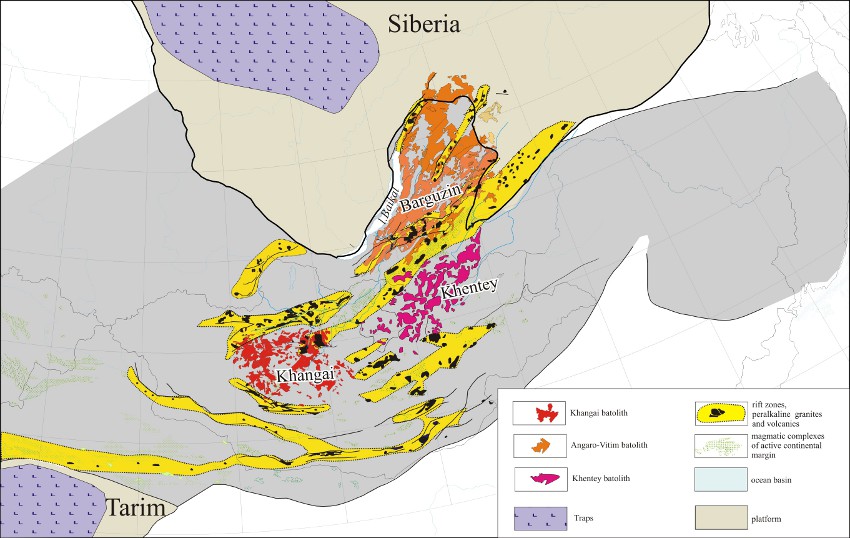
Figure 1: Geological structure of the Late Paleozoic –Early Mesozoic rift system of the Central Asia from (23, 35, 42).
The rift system was formed in the marginal part of the Siberian continent, which during the Early Carboniferous (350-320 Ma) was a regime of active continental margin. Rifting began near the border of the continent at the end of the Late Carboniferous after a break in the magmatic and tectonic activity, which amounted to no less than 10-20 Ma. Later rifting processes spread to the internal parts of the Siberian continent (36, 42, 44).
Stages of rift system evolution and features in the structure of magmatic areas of different age
Early Permian
The western part of the Tarim-South-Mongol province includes the Tarim traps (a mafic Large Igneous Province, Fig. 2). These traps occupy about 2.5 х 105 sq.km, and their age of eruption is estimated as 275 - 287 Ma (23, 49). To the east of the trap area we can distinguish the occurrences of picrite-doleritic and picritic intrusive rocks (massifs) frequently accompanied by Cu-Ni mineralization (9, 20, 21). These occur in the fault zones surrounding the Tarim and Dzhungar microcontinents in the east. The age of massifs is estimated as 292 - 275 Ma. Granitoids of increased alkalinity and alkaline granitoids as well as their volcanogenic analogs occur in association with these massifs (23).
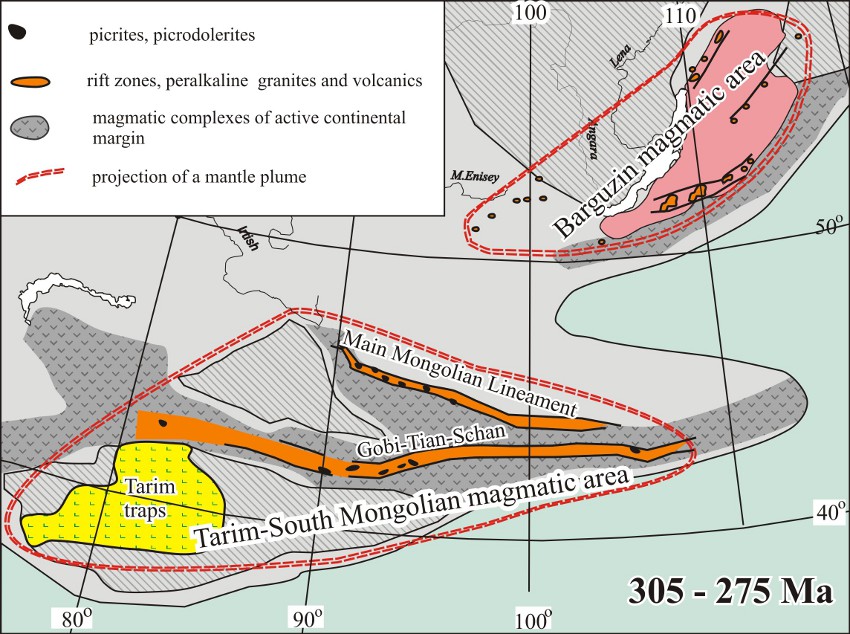
Figure 2: Locations of Early Permian magmatic areas within the margin of the Siberian continent.
The eastern part of the province involves the rift zones - Gobi-Tien Shan and the Main Mongolian Lineament (36, 37, 39). These zones are associated with the eastern continuation of basite-ultrabasite associations (Fig.2), however the composition of the magmatic complexes forming them is essentially different. They mainly include bimodal basalt-trachyrhyolite-comendite volcanic associations as well as numerous massifs of alkaline granitoids. The age of alkaline granites, estimated by the U-Pb method, basically varies in the range 302 - 284 Ma (45). The volume of the traps is estimated as 100 000 km3 (49). The amount of the magmatism produced as the result of the formation of Gobi- Tien Shan Rift zone exceeds 50 000 km3.
The Barguzin area has a zonal structure, covering more than 150 000 sq. km (Fig.3). Its central part is composed of the world's largest batholiths, the Angaro-Vitim or Barguzin batholiths, which includes biotite and biotite-hornblende granodiorites and granites, monzonitoids, syenites, granosyenites and leucogranites (18). Batholith granites are grouped into a number of separate complexes, which differ in composition and in age (17, 18, 30, 31, 37). According to the data obtained by different dating methods (U-Pb, Ar-Ar, Rb-Sr), the age of the batholith varies in the range from 330 to 280 Ma (17, 30, 31, 40). At the same time dating of batholiths by the U-Pb method from microsamples and individual zircon grains indicated that all complexes of the Angaro-Vitim batholith formed in the time span from 303±7 – to 281±1 Ma (12, 26, 40). We can infer (12) that the formation of the Angaro-Vitim batholith lasted not more than 22 Ma, and the difference in the composition of complexes mainly resulted from differences in source rocks, and depth of exposure.
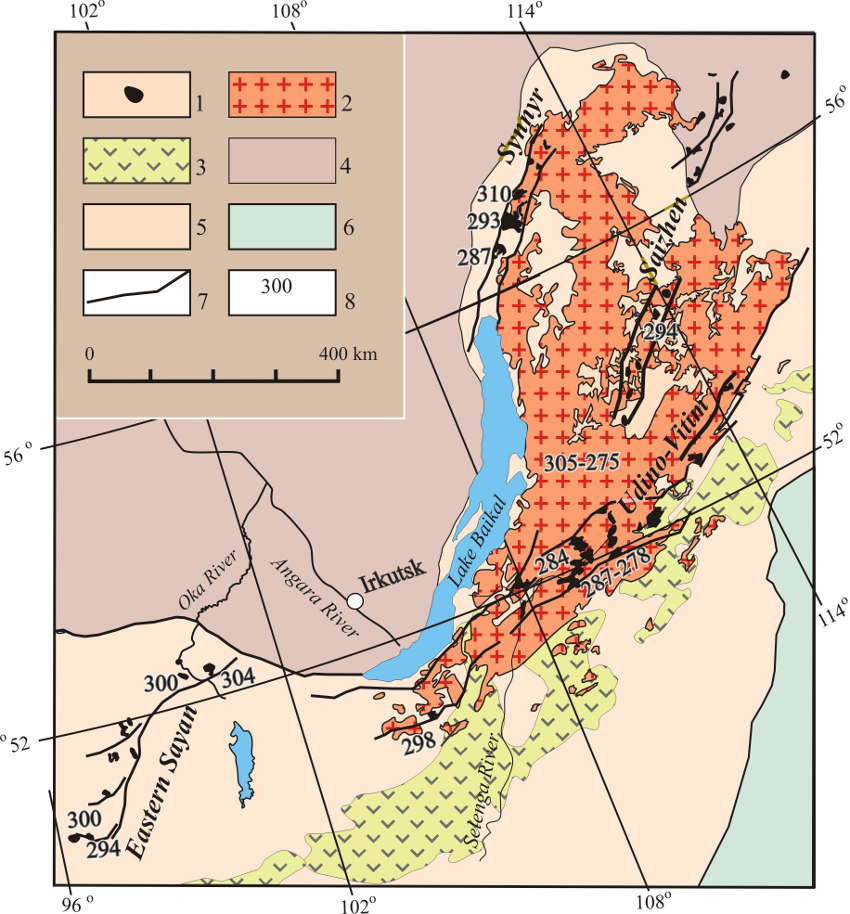
Figure 3: Simplified geological structure of the Late Paleozoic Barguzin LIP. 1 — alkaline magmatic complexes, 2 — granitoids of Angaro–Vitim batholith, 3 — volcanic complexes of active Late Paleozoic continental margin, 4 — Siberian platform, 5 — Phanerozoic folded areas, 6 — Mongol–Okhotsk ocean, 7 — major faults along alkaline magmatic complexes, 8 — age of the corresponding geological structures in Ma.
Alkaline rocks (in the rift zones) are located on the margins of the Barguzin area. These rift zones include the Udino-Vitim zone in the south which is responsible for the distribution of massifs with alkaline granites, dyke belts and volcanic rocks of bimodal associations (298-275 Ma) (17, 31, 45). The Synnyr zone occupies the northern margin. This zone involves massifs of both miaskite (nepheline and pseudoleucite syenites) and agpaitic (pulaskites and alkaline granites) alkaline rocks including shonkinites as well as subalkaline rocks (syenites, quartz syenites and granosyenites). The age of rocks from the Synnyr zone ranges from 295 to 288 Ma (24, 26, 31). One more zone (Saizhen) stretches along the batholith axis and is responsible for the location of a number of smaller massifs of alkaline ultrabasic rocks, gabbroids and syenites with ages 294-288 Ma (5, 24). The central part of the area has numerous dykes, stocks, layered bodies of subalkaline gabbroids with mingling zones on their contacts with granites.
Thus, all rocks of the Barguzin zonal area, including the granite-dominated central region and rift margins were formed simultaneously. The derived from mantle sources (gabbroids, alkaline granites) are present in all structural zones of the area.
Terminal Early Permian - beginning of Early Triassic
At this time, major Siberian traps were emplaced in the northern Siberian platform and the Khangai zonal magmatic area was formed within the rift system in the south. The area includes the Khangai batholith and the Gobi-Altai and North-Mongol rift zones surrounding the batholith from the south and north (Fig. 4).
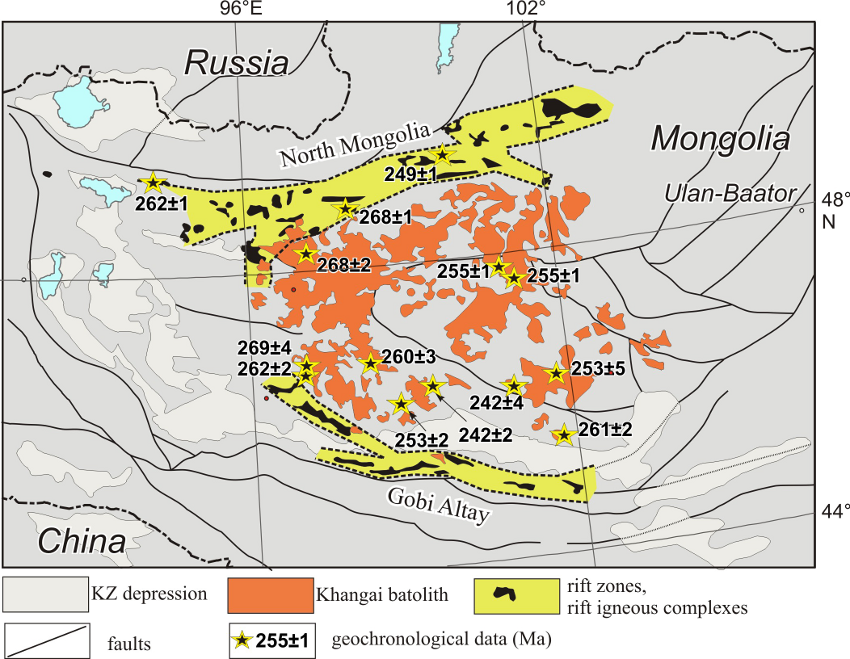
Figure 4: Geological structure of the Permian-Early Triassic Khangai zonal magmatic area.
The Khangai batholith occupies an area exceeding 150,000 sq. km and is composed of normal and subalkaline granitoids. It also comprises a number of intrusive complexes (6, 34). The early (Tarbagatai) complex includes granodiorites, tonalities, plagiogranites. The major part of the batholith is occupied by rocks of the Khangai complex, including medium-large-grained porphyry-like hornblende-biotite and biotite granodiorites and granites of normal alkalinity. At a late stage the rocks of the Sharausgol complex were emplaced; these are dominated by subalkaline leucocratic and biotite granites and granosyenites. The granites are associated with stocks, dykes, small massifs of gabbro and gabbro-diorites which by geological and geochronological data demonstrate an age similar to that of the granites. By their composition and associated Cu-Ni (with Pt) mineralization some massifs have similarities with ore-bearing layered massifs of the Tarim-South-Mongol province (7).
The age of rocks of the batholith was estimated as Carboniferous and Permian (6, 34). We determined the age from zircon (U-Pb TIMS) and from amphibole (Ar-Ar) of granitoids collected from different sites of the Khangai batholith (43). The distribution of the age determinations is shown in Fig.4. Geochronology demonstrates synchronous formation of rocks belonging to complexes of different ages. Granitoids of the Khangai batholith range from 269 to 242 Ma. These data agree with the results by other scientists (1, 8, 22, 29) and suggest that the formation of the batholith lasted about 27 Ma.
Rift zones of the area include the chains of grabens filled with the rocks of bimodal basalt-trachyrhyolite-pantellerite associations and related numerous massifs of alkaline granitoids (36, 38). The amount of the rocks erupted is estimated as approximately 75,000 km3 in the Gobi-Altai Rift Zone and 75,000 km3 in the North-Mongolian zone (36). The age of volcanic rocks from the Gobi-Altai Rift Zone is determined as late Early Permian - Late Permian based on paleovegetation data (36). The only Rb-Sr dating for volcanic rocks (274 Ma) agrees with this estimate. The age of the North-Mongolian rift zone is defined as Late Permian using the preserved flora amongst volcanic rocks (36). U-Pb, Rb-Sr and Ar-Ar age determinations fall into the time range 249-269 Ma (42).
Thus, reliable geochronological data were obtained both for the Khangai and Barguzin zonal areas. They suggest a simultaneous origin of the different-types of magmatism in rift zones and the batholith center.
It should be mentioned again that the Khangai zonal area formed simultaneously with the Siberian LIP. The magmatism of the latter was mainly governed by the traps which formed within a narrow span of time (~ 250 - 248 Ma) (25). At the same time there is evidence indicating multi-stage evolution of the igneous province (3). These features are most vivid in the Kuzbass part of the province, which is characterized by at least 6 magmatic impulses within the time range as 268 - 238 Ma. Those impulses were responsible for the origin of both traps and granitoids (3). This time interval characterizing the Siberian LIP, suggests its simultaneous formation with magmatism of the Khangai zonal area.
Late Triassic - Early Jurassic
The Khentey zonal magmatic area terminated the formation of the rift system on its eastern margin. The area comprises the West-Transbaikal, Kharkhorin and North-Gobi rift zones which surround the Khentey batholith located between them from the north, west and south (Fig.5) (13, 41). The Khentey batholiths represent a large group of large plutons occurring over an area of more than 120 000 sq. km. They include granitoids of a wide compositional spectrum (from granodiorites to leucogranites (11, 13, 33). Smaller massifs of Li-F granites are found on the margins of the batholith. Gabbro and diorites are not abundant. They compose separate bodies corresponding to the initial phases of intrusion or occur amongst granitoids of the main phase as drop-like separations (11) belonging to synplutonic intrusions of the basite magmas. According to the geochronological data (13, 41) the batholith was emplaced from 225 to 195 Ma.
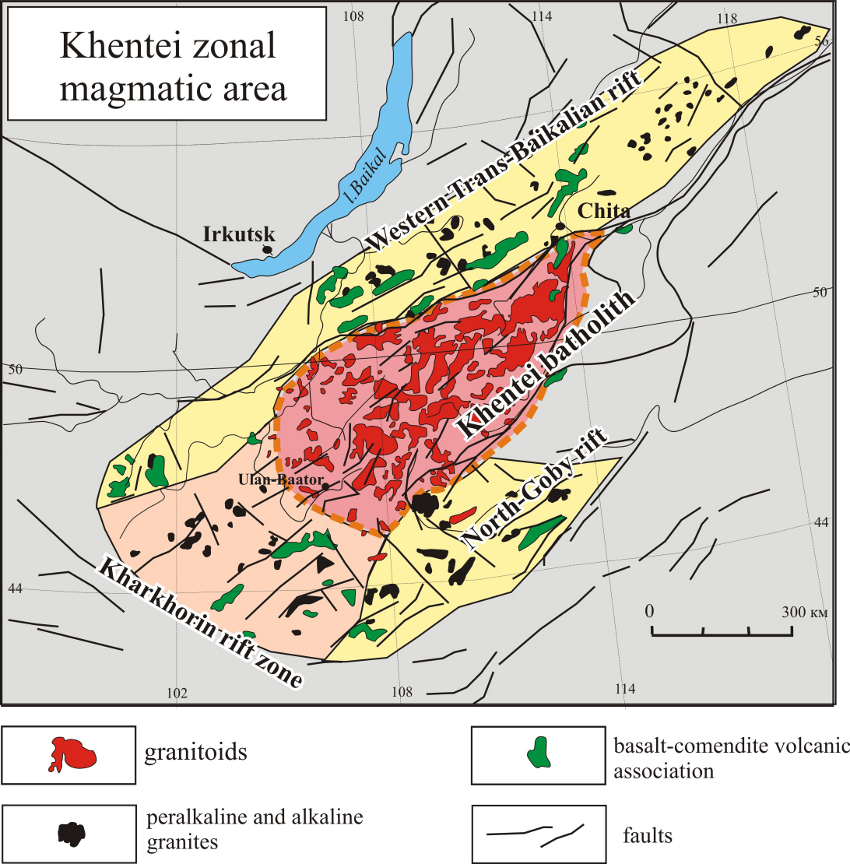
Figure 5: Geological structure of the Late Triassic Khangai zonal magmatic area.
The rift zones of the area include systems of grabens, filled by the rocks of the bimodal and alkaline-granitoid associations. They are related to the massifs of Li-F granites and the belt of longitudinal dykes of basic and alkaline-salic composition. The largest Western-Transbaikal rift zone is located on the north framing of the Khentey batholith. It is accompanied by the bimodal volcanic associations containing comendites and pantellerites of the Tsagan-Khurtei series as well as alkaline granites of the Malokunalei complex (37, 38, 45). The age of the erupted and intrusive rocks is estimated as 230 - 210 Ma (13, 17, 45).
Li-F and alkaline granites as well as bimodal volcanic associations are abundant in the Kharkhorin and North-Mongol rift zones (12, 42). Li-F granites mainly occur on the margins of the Khentey batholith. Alkaline granites and their volcanic analogs (trachyrhyolites and pantellerites) are more typical of the outer margin of the zonal area remote from the batholith. The age of these rocks is determined as 221-196 Ma.
The nature of zonal areas
The general characteristics of zonal areas are: 1) the association with the Late Paleozoic-Early Mesozoic rift systems of Central Asia and 2) the presence of giant granitoid batholiths between the separate rift zones and their simultaneous emplacement with the rifting (37). The batholiths are huge; considering their average thickness, they are up to 5 – 7 km (32); the batholiths have a volume greater than 0.5 million km3. The origin of these batholiths is strongly connected to the origin of rift systems and zonal areas of magmatism.
One of approaches to understanding the origin of these batholiths is to investigate their isotope-geochemical characteristics and compare with potential crustal sources for the melts. We studied the isotope Nd composition of granitoids of the Khangai batholith and the hosting crust (48). The Early Precambrian (Dzabkhan and Tarbagatai), Neoproterozoic (Songin, Khangai) and Caledonian (Dzhida and Gobi-Altai) blocks occur in the area (Fig.6). These blocks belong to diverse Nd-isotope crustal provinces, having different εNd values. εNd (260) values vary from--30 - 15 in blocks containing the Early Proterozoic crust and up to +1 - +2 in Caledonides (48).
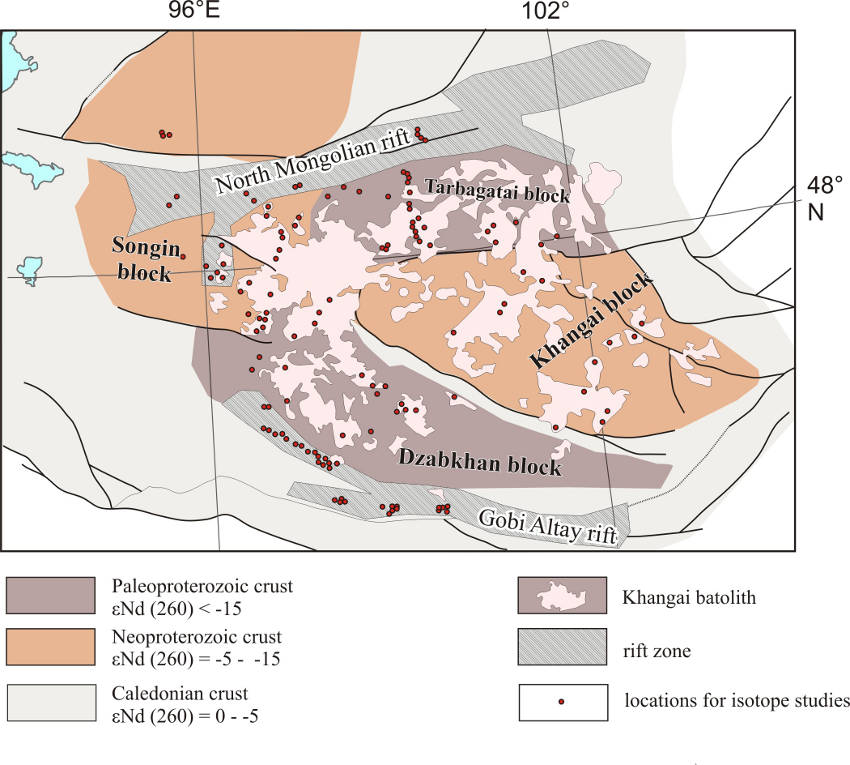
Figure 6: Scheme of zoning of the Khangai magmatic area crust regarding the age of its formation and Nd isotope composition. Points locate sampling sites for isotope studies.
The composition of the inferred crustal source of the Khangai batholith does not correlate with the parameters of the observed hosting crust. As the plot (Fig.7) demonstrates these batholiths compositions vary over a wide range, from the composition of the hosting crust to the composition of basites from rifting associations. The granites, isotope parameters of which demonstrate εNd (260) values of – 3 - + 1, are predominant. The observed variations cannot be explained by the contribution of only crustalal protoliths in the origin of granites. The source of granitic melts contained another component that most likely was similar to the mantle sources of basites of the North-Mongol and Gobi Altai rift zones and basites of synplutonic intrusions (εNd (260) =-1 - +1). Thus, the isotope data indicate the contribution of both crustal and basite (juvenile) components in the source of granitic melts. The best evidence for an associated mantle magma source is provided by the synplutonic intrusions of basic rocks (18) which are present in all three batholiths. By composition they correspond to the alkaline basaltoids (18, 40). The share of the basic rocks, in the Angaro-Vitim batholith is estimated as up to 10 % of total amount (18).
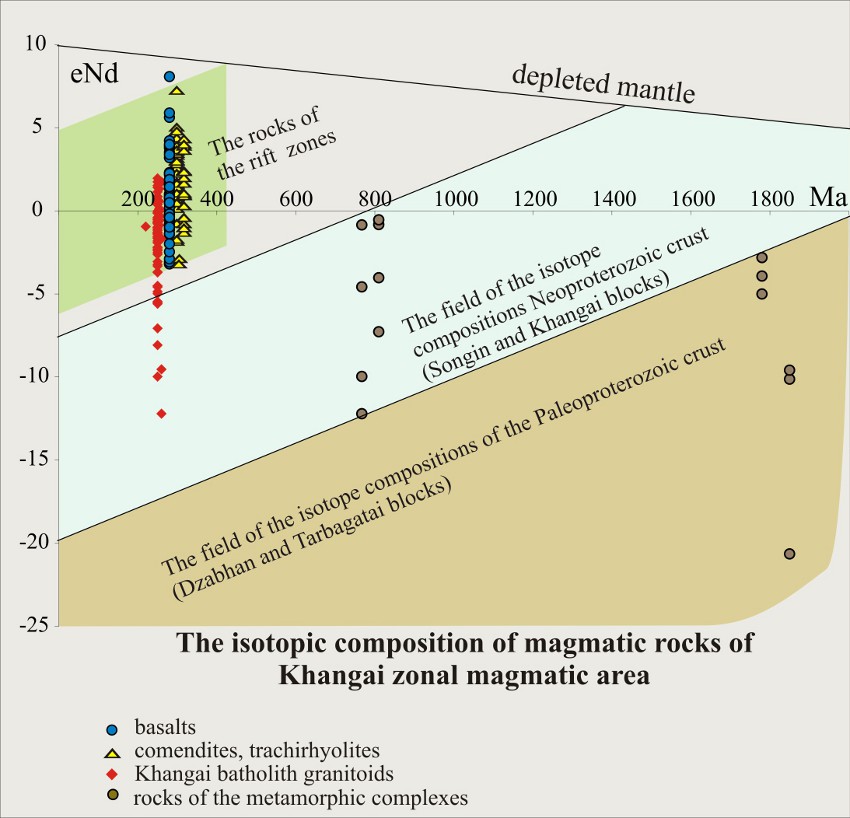
Figure 7: Isotope composition of rocks from the Khangai zonal magmatic area and the hosting crust on εNd – T diagram. A grey arrow indicates the trend of evolution in the isotope composition of the average crust (147Sm/144Nd = 0.12) accepted for the reconstructions of changes of the crust in time.
Considering these data as well as the data regarding the spatial and age specific features of the areas we can suggest the association with mantle plumes (14, 38, 39). The contribution of the mantle plumes in the origin of zonal areas can be explained by an underplate model wherein intrusion of mantle magmas into the crustal basement provoked crustal anatexis. Following the viewpoint of N.L.Dobretsov (4) the total amount of such melts is comparable to the volume of the batholiths, i.e. can exceed 0.5 million km3. It makes possible to regard the zonal magmatic areas as equivalents of large igneous provinces (LIPs). These can be termed silicic large igneous provinces (2).
We therefore explain the zonal distribution of magmatic products and the predominance of its plutonic analogs in the central part of the areas by plume activity, but note that the geodynamic setting is that of an active continental margin. It is hypothesized that the conditions of compression prevented ascent of plume generated mafic magmas, and instead led to trapping of magma as an underplate which then led to crustal melting and eventual emplacement of this granitic magma into crust and formation of batholiths.
Late Paleozoic – Early Mesozoic plume activity and its geodynamic nature
In Northern Asia the intraplate activity developed in the following succession: 1. Terminal Carboniferous – Early Permian: origin of the Barguzin zonal area and Tarim-South-Mongol province within the bounds of the active continental margin (ACM) of the Siberian paleocontinent. 2 Terminal Early Permian –Early Triassic: origin of the Khangai area in a part of the continent remote from the active margin and simultaneous formation of the Siberian LIP in the center of the continent with abundant eruptions of traps in the Permian-Triassic, 3 Origin of the Khentey area in the inner part of the united Siberian-North-China continent (Fig. 8). The combined effect of this intraplate activity caused the rift system of the Central Asia. It evolved as the sequence of rifting zones migrating inward from the margin towards the inland of the continent starting from the Late Carboniferous and continuing up to the Triassic inclusive. A similar migration is observed with the overthrust of the paleocontinent on the group of mantle plumes belonging to the African mantle field (14).
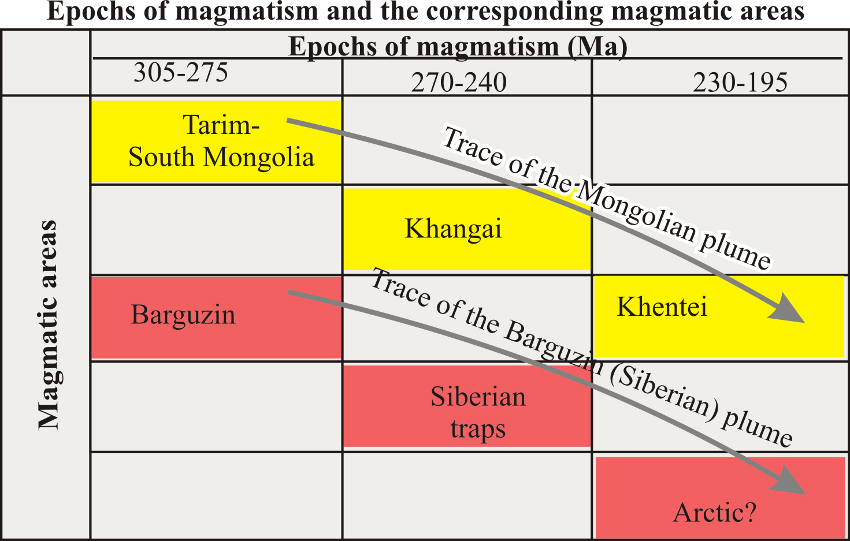
Figure 8: Correlation of major magmatic events in the formation of the rift system in Central Asia.
We can suggest at least two simultaneously existing mantle plumes and that the lithosphere of the Siberian continent migrated over these plumes (Fig. 9). Their impact in the lithosphere of the Siberian continent started in the terminal Carboniferous when the Tarim-South-Mongol province and the Barguzin zonal area originated. We connect the change in their location under the continent with the rotation of the Siberian continent clockwise that occurred at that time. As a result the Siberian Platform was above the “Barguzin” (Siberian) mantle plume and the traps erupted there at the Permo-Triassic boundary. From the second half of the Triassic the magmatic centers were most likely shifting to the shelf of the Arctic basin (10, 14). Following (15, 16, 19) we believe that the Siberian mantle plume can be linked with the modern Icelandic plume over which the Siberian continent passed in the Late Paleozoic-Early Mesozoic.
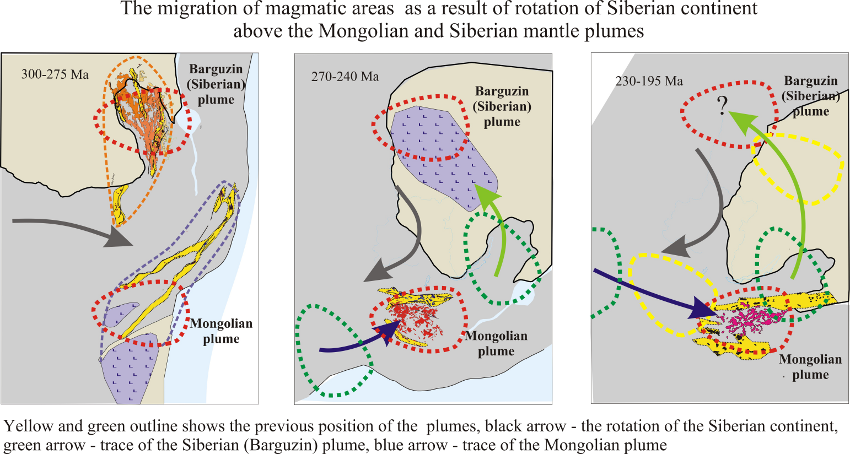
Figure 9: Migration of magmatic areas in the formation of the rift system in the Central Asia as a result of rotation of Siberia over the Siberian and Mongolian hot spots. Red dotted outlines = the position of mantle plumes. Yellow and green outlines = the previous position of the plumes. Black arrow = the rotation of the Siberian continent. Green arrow = trace of the Siberian (Barguzin) plume. Blue arrow = trace of the Mongolian plume.
A similar pattern is typical of the activity related to the second Mongolian hot spot. The Tarim-South-Mongolian province was formed by 280-275 Ma and later the area of plume activity shifted within the Khangai area (270-240 Ma) and then in the Early Mesozoic it shifted into Eastern Mongolia and Transbaikalia. It should be emphasized that although the locus of rifting changed with time, the magmatic compositions associated with the different pulses of rifting remained similar.
CONCLUSION
The largest batholiths of Asia, the Angaro-Vitim, Khangai and Khentey, was formed in the Late Paleozoic- Early Mesozoic between 305 and 195 Ma. The formation of each batholiths lasted about 25 Ma. Each of them includes a huge amount of granitoids; according to the geophysical data the total amount of these granitoids can be estimated as 0.5 million km3.
The formation of batholiths is closely connected with the evolution of the Late Paleozoic – Early Mesozoic rift system of the Central Asia. Batholiths that formed around the rift zones exhibit a unique concentric zonal pattern of magmatism.
The formation of the rift system occurred as a result of the overthrust of the Siberian continental plate onto a mantle area containing upwelling plumes. Over plumes within cratons were formed thetrap-dominated Tarim and Siberian provinces (mafic LIPs). The impact of plumes on the crust of the continental margins led to its melting in a large scale and origin of batholiths (silicic LIPs).
Temporal and volumetric parameters of magmatic products of the zonal areas correspond to the criteria proposed in (2, 27), that allows considering the batholiths of the Central Asia as silicic large igneous provinces.
Acknowledgement
The authors are grateful to Richard Ernst for his help in preparing this report.
References
1. Arakawa J., Naito K., Takahashi Y., Oyungerel S., Amakawa H., 1999. New K-Ar and Rb-Sr ages of Khangay granite, central Mongolia // Mongolian Geoscientist, № 12, p. 32—35.
2. Bryan S.E., Ernst R.E., 2008. Revised definition of Large Igneous Provinces (LIPs) // Earth-Science Reviews 86. р.175–202
3. Dobretsov N.L., Borisenko A.S., Izokh A.E., Zhmodik S.M. 2010. A thermochemical model of Eurasian permo-triassic mantle plumes as a basis for prediction and exploration for Cu-Ni-PGE fnd rare-metal ore deposits // Russian geology and geophysics. 39. p. 972-994
4. Dobretsov N.L. 2005. 250 Ma large igneous provinces of Asia: Siberian and Emeishan traps (plateau basalts)and associated granitoids // Russian Geology and Geophysics. Vol. 46, No. 9. p. 847-868
5. Doroshkevich AG, Ripp G.S. 2010. The first geochemical data on the Late Paleozoic alkaline magmatism of the ultrabasic-basic Vitim province, western Transbaikalia. In: Sklyarov E.V. (Ed.), Geodynamic evolution of lithosphere of Central Asian mobile belt. V.8. part1. Irkutsk. IEC SB RAS. V.1. p. 104-107.
6. Fedorova, M.E., 1998. Geologic occurrence and petrology of granitoids of the Hangayn batholith [in Russian], Nauka, Novosibirsk, 150 pp.
7. Izokh A.E., Vishnevskii A.V., Polyakov G.V., Shelepaev R.A. 2011. Age of picrite and picrodolerite magmatism in Western Mongolia // Russian geology and geophysics. №1. . 7-23
8. Jahn B.M., Capdevila R., Liu D.Y., Badarch G., 2004. Sources of Phanerozoic granitoids in Mongolia: geochemical and Nd isotopic evidence, and implications for Phanerozoic crustal growth // J. Asian Earth Sci., v. 23, p. 629—653.
9. Shi Ping Chen, Lin Song Cheng, Jian Min Yang, Chang Qing Zhang, 2008. A review of the Cu–Ni sulphide deposits in the Chinese Tianshan and Altay orogens (Xinjiang Autonomous Region, NW China): Principal characteristics and ore-forming processes // Journal of Asian Earth Sciences. V 32. P 184–203
10. Kharin, G.S., 2000. Magmatic Pulses of the Iceland Plume. // Petrology. v. 8 №2. 97–112
11. Koval’, P.V., 1998. A regional geochemical analysis of granitoids NITs OIGGM. Novosibirsk. 487 pp. [in Russian]
12. Kovach V.P., Salnikov E.B., Rytsk E.J., Yarmolyuk V.V., Kotov A.B., Anisimova I.V., Yakovleva S.Z., Fedoseenko A.M., Plotkin S.V. 2011. Duration of the formation of the Angaro-Vitim batholith and the problem of using the geochronological data in studies of Phanerozoic igneous complexes. In: Sklyarov E.V. (Ed.), Geodynamic evolution of lithosphere of Central Asian mobile belt. V.9. Irkutsk. IEC SB RAS. p. 103-105
13. Kovalenko V. I., Yarmolyuk V. V., Sal’nikova E. B., Budnikov S. V., Kovach V. P., Kotov A. B., Ponomarchuk V. A., Kozlov V. D., Vladykin N. V. 2003. Sources of Igneous Rocks and Genesis of the Early Mesozoic Tectonomagmatic Area of the Mongolia–Transbaikalia Magmatic Region: 1. Geology and Isotope Geochronology // Petrology. Vol. 11, No. 2, p. 147-160
14. Kuzmin M. I., Yarmolyuk V. V., Kravchinsky V. A., 2010. Phanerozoic hot spot traces and paleogeographic reconstructions of the Siberian continent based on interaction with the African large low shear velocity province // Earth-Science Reviews, V. 102. № 1-2, P. 29-59
15. Lawver, L.A., Grantz, A., Gahagan, L.M., 2002, Plate kinematic evolution of the present Arctic region since the Ordovician. In: E.L. Miller, A. Grantz and S.L. Klemperer (Editors), Tectonic Evolution of the Bering Shelf-Chukchi Sea-Arctic Margin and Adjacent Landmasses, Special Paper. Geological Society of America, Boulder, CO, p. 333–358.
16. Lawver, L.A., Muller R.D., 1994. Iceland hotspot track. Geology 22 (4), 311–314.
17. Litvinovsky B.A., Tsygankov A.A. Jahn B.M., Katzir Y., Be'eri-Shlevin Y., 2011. Origin and evolution of overlapping calc-alkaline and alkaline magmas: The Late Palaeozoic post-collisional igneous province of Transbaikalia (Russia) // Lithos. 125. р. 845–874
18. Litvinovsky, B.A., Zanvilevich, A.N., Alakshin, A.M., Podladchikov, Yu.Yu., 1992. Angaro-Vitim batholith – largest granitoid pluton. Novosibirsk, Nauka, pp. 141 (in Russian).
19. Lundin E.R., Doré, A.G., 2005. The fixity of the Iceland “hot spot” on the Mid-Atlantic Ridge: observational evidence, mechanism and implications for Atlantic volcanic margins. // Geol.Soc. of America. Special Paper. 388, 627–651.
20. Mao J.W., Xiao W.J., Han СМ., Sun M., Yuan C, Yan Z., Li J.L., Yong Y, Zhang J.E. , 2006. Zircon U-Pb age and the geochemistry of the Baishiquan mafic-ultramafic complex in the eastern Tianshan, Xinjiang province: constrains on the closure of the Paleo-Asian Ocean //Acta Petrol. Sinica, v. 22, № 1, p. 153—162.
21. Mao J.W.,Pirajno F.,Zhang Z.H.,Chai F.M.,Wu H.,Chen S.P., Cheng L.S., Yang J.M., Zhang C.Q., 2008. A review of the Cu-Ni sulphide deposits in the Chinese Tianshan and Altay orogeris (Xinjiang Autonomous Region, NW China): principal characteristics and ore-forming processes // J. Asian Earth Sci, v. 32, p. 184—203.
22. Orolmaa D., Erdenesaihan G., Borisenko A.S., Fedoseev G.S., Babich V.V., Zhmodik S.M., 2008. Permian-Triassic granitoid magmatism and metallogeny of the Hangayn (central Mongolia) // Russian geology and geophysics. №7 p. 534-544
23. Pirajno F., Jingwen M., Zhaochong Z., Zuoheng Z., Fengmei C., 2008. The association of mafic—ultramafic intrusions and A-type magmatism in the Tian Shan and Altay orogens, NW China: implications for geodynamic evolution and potential for the discovery of new ore deposits // J. Asian Earth Sci., v. 32, p. 1165—183.
24. Pokrovskii B.G. and Zhidkov A.Ya., 1993. Sources of Material for High-K Alkaline Rocks from the Synnyr and South Sakum Massifs in Transbaikalia from Isotopic Data. //Petrology,. v.1. №2, pp. 195–204.
25. Reichow M.K., Pringle M.S., Al’Mukhamedov A.I., Allen M.B., Andreichev V.L., Buslov M.M., Davies C.E., Fedoseev G.S., Fitton J.G., Inger S., Medvedev A. Ya., Mitchell C., Puchkov V.N., Safonova I.Yu., Scott R.A., Saunders A.D. 2008. The timing and extent of the eruption of the Siberian Traps large igneous province: Implications for the end-Permian environmental crisis // Earth and Planetary Science Letters. № 9, v. 277, p. 9—20.
26. Rytsk E. Yu. Kovach V. P., Yarmolyuk V. V., Kovalenko V. I., Bogomolov E. S., Kotov A. B., 2011. Isotopic Structure and Evolution of the Continental Crust in the East Transbaikalian Segment of the Central Asian Foldbelt // Geotectonics. Vol. 45, No. 5, p. 349-377
27. Sheth H. C., 2007. ‘Large Igneous Provinces (LIPs)’: Definition, recommended terminology, and a hierarchical classification // Earth-Science Reviews 85. р. 117–124
28. Sugorakova A. M., Yarmolyuk V. V., Lebedev V. I., Lykhin D. A., 2011. Late Paleozoic Alkali–Granitic Magmatism of Tuva and Its Relation to Intraplate Activity
within the Siberian Paleocontinent Doklady Earth Sciences. V. 439, № 2. р. 1070-1075
29. Takahashi Y., Arakawa J., Oyungerel S., Naito K., 2000. Geochronological data of granitoids in Bayankhongor area, Central Mongolia // Bull. Surv. Japan, v. 51 (5), p. 167—174.
30. Tsygankov A.A, Litvinovsky B.A., Jahn B.M., Reichow M., Liu D.Y., Larionov A.N., Presnyakov S.L., Lepekhina Ye.N., Sergeev S.A., 2010. Sequence of magmatic events in the Late Paleozoic of Transbaikalia, Russia (U-Pb isotope data ) // Russian geology and geophysics. 39. p. 972-994
31. Tsygankov, A.A., Matukov, D.I., Berezhnaya, N.G., Larionov, A.N., Posokhov, V.F., Tsyrenov, B.Ts., Chromov, A.A., Sergeev, S.A., 2007. Late Paleozoic granitoids of western Transbaikalia: magma sources and stages of formation. // Russian Geology and Geophysics. 48 (1), 156-180.
32. Turutanov E.Kh., Mordvinova V.V., Ananyin L.V. 2011. Deep structure of the Angaro-Vitim granitoid field from the geophysical data // Large igneous provinces of Asia. Irkutsk. IEC SB RAS. p. 281-283
33. Yanshin, A.L. (Ed.), Mesozoic and Cenozoic tectonics and magmatism of Mongolia. 1975. Nauka. Moscow. 305 pp. [in Russian].
34. Yanshin, A.L. (Ed.), Tectonics of Mongolia. 1974. Nauka, Moscow, 284 pp. [in Russian]
35. Yarmolyuk V. V., 1983. Late Paleozoic Volcanism of Continental Rift Structures in Central Asia Nauka, Moscow. 193 р. [in Russian].
36. Yarmolyuk, V.V., Kovalenko, V.I., 1991. Rift magmatism of active continental margins and its ore potential. Moscow, Nauka, 263 pp. (in Russian).
37. Yarmolyuk, V.V., Kovalenko, V.I., 2003. Batholiths and geodynamics of batholith formation in the Central Asian folded belt. Russian Geology and Geophysics, 44 (12), 1260-1274.
38. Yarmolyuk, V.V., Kovalenko, V.I., 2003. Deep geodynamics and mantle plumes: role in formation of the Central-Asian folded belt. Petrology, 11 (6), 504–531.
39. Yarmolyuk, V.V., Kovalenko, V.I., and Kuzmin, M.I., 2000. North Asian Superplume Activity in the Phanerozoic: Magmatism and Geodynamics. // Geotectonics 5, 343-366.
40. Yarmolyuk, V.V., Kovalenko, V.I., Kotov, A.B., and Sal'nikova, E.B., 1997. The Angara–Vitim Batholith: On the Problem of Batholith Geodynamics in the Central Asia Foldbelt. Geotectonics 5, 359-373.
41. Yarmolyuk, V.V., Kovalenko, V.I., Sal'nikova, E.B., Budnikov, C.V., Kovach, V.P., 2002. Tectono-Magmatic Zoning, Magma Sources, and Geodynamics of the Early Mesozoic Mongolia–Transbaikal Province. Geotectonics 4, 293-311.
42. Yarmolyuk V.V., Kovalenko V.I., Kozlovsky A.M., Vorontsov A.A., Savatenkov V.M., 2005. Late Palaeozoic–Early Mesozoic Rift System of Central Asia: composition of magmatic rocks, sources, order of formation and geodynamics. In: Kovalenko, V.I. (Ed.), Tectonic Problems of Central Asia. World of Science Publisher, Moscow. pp. 197–226. (in Russia)
43. Yarmolyuk V.V., Kovalenko V.I., Kozakov I.K., Sal’nikova, E.B., Bibikova, E.V., Kovach, V.P., Kozlovsky, A.M., Kotov A.B., Lebedev, V.I., Eenjin, G., Fugzan M.M., 2008. The Age of the Khangai batholith and the problem of batholith formation in Central Asia. // Doklady Earth Sciences. 423 (8), 1223–1228
44. Yarmolyuk, V.V., Kovalenko, V.I., Sal'nikova, E.B., Kovach, V.P., Kozlovsky, A.M., Kotov, A.B., Lebedev, V.I., 2008. Geochronology of igneous rocks and formation of the Late Paleozoic south Mongolian active margin of the Siberian continent. // Stratigraphy and geologic correlation, 16 (2), 162–181.
45. Yarmolyuk V.V., Litvinovsky B.A., Kovalenko V.I., Jahn Bor- Ming, Zanvilevich A.N., Vorontsov A.A., Zhuravlev D.Z., Posokhov V.F., Kuz'min D.V., Sandimirova G.P., 2001. Formation Stages and Sources of the Peralkaline Granitoid Magmatism of the Northern Mongolia–Transbaikalia Rift Belt during the Permian and Triassic. // Petrology. 9 №4. p. 351–380.
46. Yarmolyuk V. V., Lykhin D. A., Shuriga T. N., Vorontsov A. A., Sugorakova A. M., 2011. Age, Composition of Rocks, and Geological Setting of the Snezhnoe Beryllium Deposit:
Substantiation of the Late Paleozoic East Sayan Rare-Metal Zone, Russia // Geology of Ore Deposits. Vol. 53, No. 5. p. 390-401
47. Yarmolyuk V. V., Nikiforov A. V., Sal’nikova E. B., Travin A. V., Kozlovsky A. M., Kotov A. B., Shuriga T. N., D. A. Lykhin D. A., Lebedev V. I., Anisimova I. V., Plotkina Yu. V., and Yakovleva S. Z., 2010. Rare_Metal Granitoids of the Ulug-Tanzek Deposit (Eastern Tyva): Age and Tectonic Setting. Doklady Earth Sciences, Vol. 430, Part 1, pp. 95–100.
48. Yarmolyuk V.V., Kovach, V.P., Kozakov I.K., Kozlovsky A.М., Kotov A.B., Rytsk E.Yu. Mechanisms of formation of continental crust of the Central Asian fold belt (geological and isotopic-geochemical data) // Geotectonics, in press.
49. Zhong C.-L., Li X.-H., Li Z.-X., Ye H.-M., Li C.-N., 2008. A Permian layered intrisuve complex in the western Tarim Block, northwestern China: product of a ca. 285-Ma mantle plume // J. Geol., v. 16, p. 269—287.
